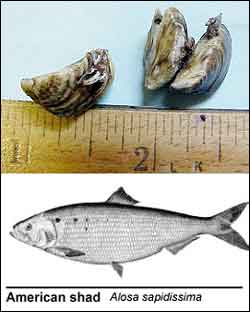Muscling Their Way Into the Food Chain: Zebra Mussels Alter Fish Populations in the Hudson River

In 1991, an exotic bivalve called the zebra mussel moved into the Hudson River. Over the past two decades, the prolific species has colonized habitats with hard sediments, becoming the most abundant animal in the river’s freshwater reaches. As competitors in the aquatic food chain, scientists have long speculated that zebra mussels may impact fish. A recent Canadian Journal of Fisheries and Aquatic Sciences article, written by Dr. David L. Strayer of the Institute of Ecosystem Studies (IES) and Drs. Kathryn A. Hattala and Andrew W. Kahnle of the NY State Department of Environmental Conservation (NYSDEC), has revealed that open-water fish species, like the commercially important American shad, are declining in response to the exotic invader.
Invasive species research is often limited by a lack of ecological data on pre-invasion conditions. Since the 1970s, utility companies on the Hudson River have gathered long-term data on juvenile fish populations as a condition of withdrawing cooling water from the river. These surveys began prior to the zebra mussel introduction, allowing for pre and post invasion assessment. Hudson River food web data has been collected by IES since the 1980s. Through analysis of this data, Strayer and colleagues have discovered that open-water fish, such as American shad and striped bass, have decreased in growth and abundance since the zebra mussel invasion. Conversely, species like sunfishes, which prefer vegetated shoreline habitat, have increased significantly.
Many of the open-water fish population declines were large and involved species of commercial or recreational importance, such as American shad and black bass. Strayer notes, “The changes we observed may lead to fewer adults of species such as American shad, and more adults of species such as redbreast sunfish in the Hudson. Maintaining a sustainable fishery for species like American shad, in the face of sharp population reductions, will be challenging. When a river’s ability to support young fish changes, it becomes more difficult to develop and evaluate sound management strategies.”
Why are open-water fish and vegetated shoreline fish impacted so differently? The answer is how the river responds to the zebra mussel’s prodigious appetites. Adult zebra mussels feed by grazing on food particles suspended in the water column. There are so many zebra mussels in the Hudson River that they filter all of the water in the river every 1-4 days, removing the microscopic plants and animals that make up their diet. This can be problematic for fish species that rely on the same food resources. “Zebra mussels have significantly reduced populations of zooplankton and other animals that are a dietary staple of open-water larval and juvenile fish,” Strayer comments.
When mussel beds remove food particles, a byproduct is increased light penetration. In shallow light-limited areas, increased sunlight results in the growth of aquatic plants and the invertebrates associated with them, creating more fish food in vegetated shorelines. Thus when zebra mussels abound, open-water food resources decline and shoreline food resources increase. This explains the population shifts Strayer and colleagues observed, with open-water species moving downriver, away from the invasion, and shoreline species moving upriver.
This has been the first study to link the spread of the zebra mussel to the management of the affected fish species in the Hudson River.
Media Contact
More Information:
http://www.ecostudies.orgAll latest news from the category: Ecology, The Environment and Conservation
This complex theme deals primarily with interactions between organisms and the environmental factors that impact them, but to a greater extent between individual inanimate environmental factors.
innovations-report offers informative reports and articles on topics such as climate protection, landscape conservation, ecological systems, wildlife and nature parks and ecosystem efficiency and balance.
Newest articles

A universal framework for spatial biology
SpatialData is a freely accessible tool to unify and integrate data from different omics technologies accounting for spatial information, which can provide holistic insights into health and disease. Biological processes…

How complex biological processes arise
A $20 million grant from the U.S. National Science Foundation (NSF) will support the establishment and operation of the National Synthesis Center for Emergence in the Molecular and Cellular Sciences (NCEMS) at…

Airborne single-photon lidar system achieves high-resolution 3D imaging
Compact, low-power system opens doors for photon-efficient drone and satellite-based environmental monitoring and mapping. Researchers have developed a compact and lightweight single-photon airborne lidar system that can acquire high-resolution 3D…





















